Gold soars to record high over $3,900/oz amid yen slump, US rate cut bets
Introduction & Market Context
Heritage Insurance Holdings Inc (NYSE:HRTG) presented its second quarter 2025 results on August 6, showcasing a significant earnings improvement and strategic shift toward controlled growth after years of focusing on profitability. The super-regional property and casualty insurer reported a substantial increase in earnings before taxes while maintaining its geographic diversification strategy.
The presentation comes as Heritage’s stock has shown strong momentum, closing at $21.21 with a 2.22% increase on the day of the presentation. According to the most recent data, the stock has experienced remarkable growth over the past year, trading well above its 52-week low of $7.09, though still below its 52-week high of $26.64.
As shown in the following company overview, Heritage has established itself as a geographically diversified insurer with a significant presence across multiple U.S. regions:
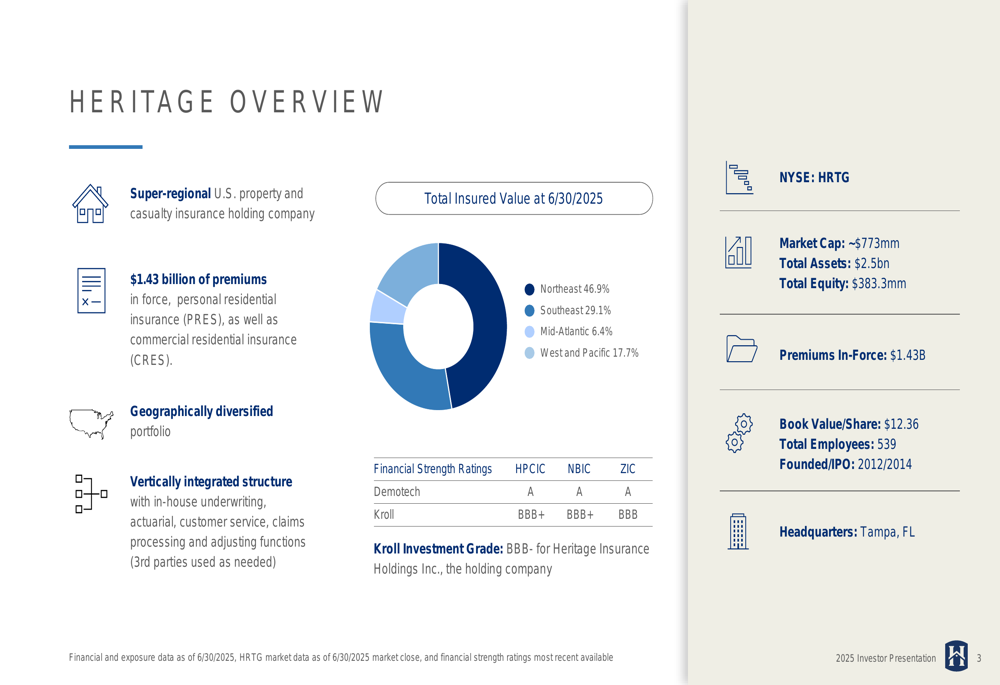
Q2 2025 Performance Highlights
Heritage reported impressive financial results for Q2 2025, with earnings before taxes of $63.0 million, representing a substantial increase of $38.1 million compared to the same period last year. While premiums-in-force showed modest growth of 0.5% year-over-year to $1,429.5 million, gross premiums written decreased slightly by 3.2% to $410.968 million.
The company’s Q2 performance continues the positive momentum from Q1 2025, when Heritage significantly exceeded earnings expectations with an EPS of $0.99 compared to the forecasted $0.33.
The following slide details the Q2 2025 operating performance metrics:
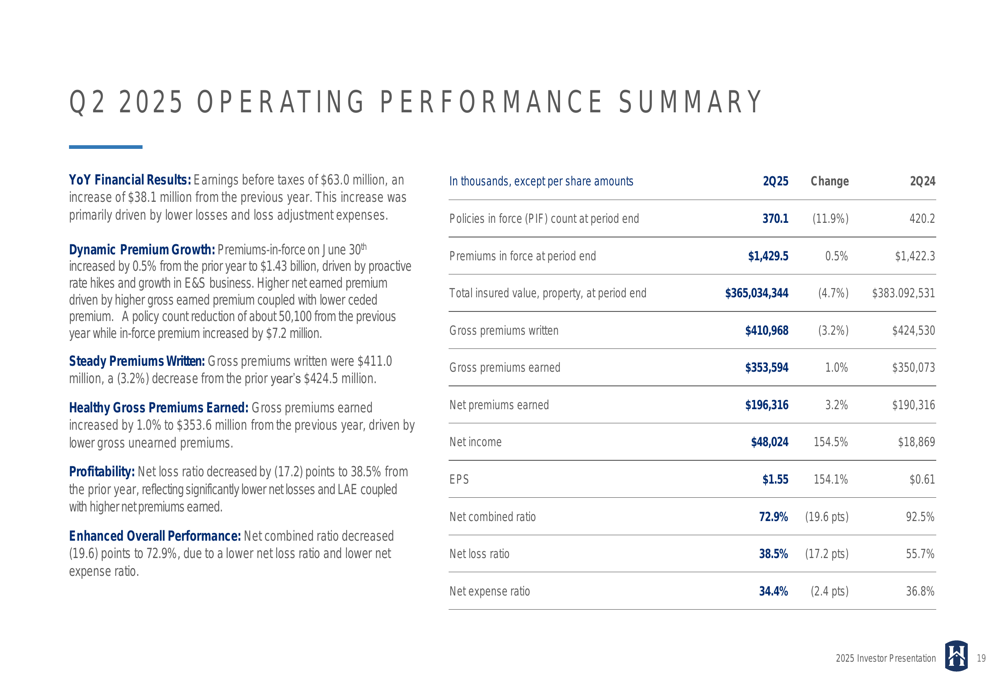
Heritage’s financial recovery has been remarkable over the past three years, transitioning from a significant net loss in 2022 to substantial profits in subsequent years. The company’s net income trajectory shows the dramatic improvement: from a loss of $154,362 in 2022 to profits of $45,307 in 2023 and $61,539 in 2024. It’s worth noting that each of these years included significant catastrophe losses from events such as Hurricane Ian in 2022, Hurricane Idalia and Maui wildfires in 2023, and Hurricanes Debby, Helene, and Milton in 2024.
This financial turnaround is clearly illustrated in the following chart:
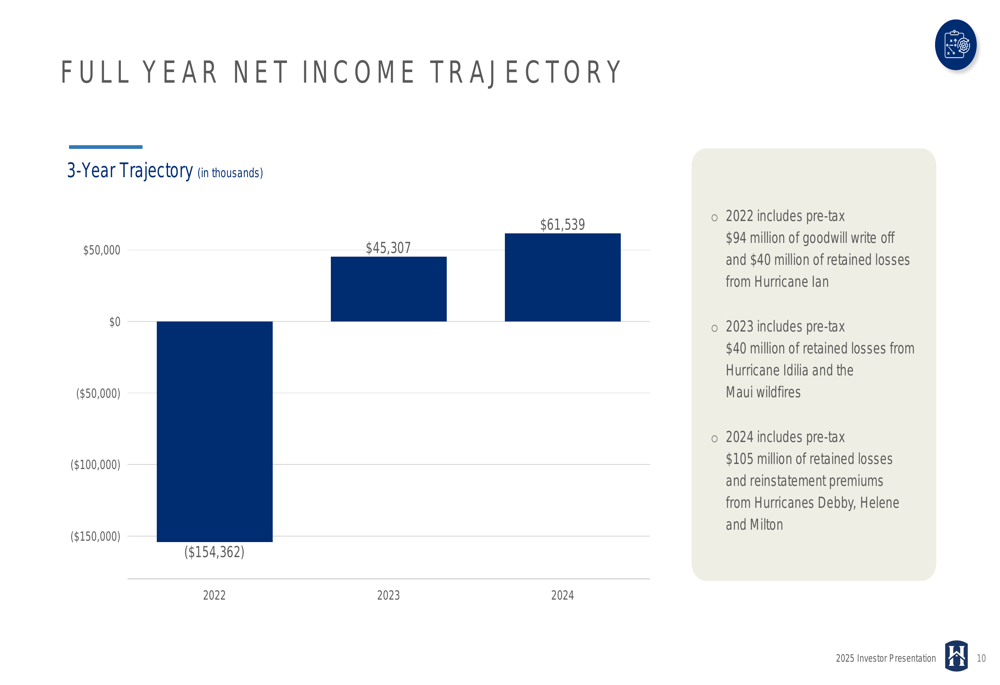
Strategic Initiatives and Growth Strategy
After focusing primarily on bottom-line improvement from 2021 to 2024, Heritage is now pivoting to a controlled growth strategy while maintaining its emphasis on profitability. The company had previously ceased underwriting new personal lines in the Northeast and Florida in December 2022 as part of its profitability initiatives but has now begun writing new personal lines business again.
The company’s evolution is captured in this timeline showing the transition from top-line focus to bottom-line focus, and now to managed growth:
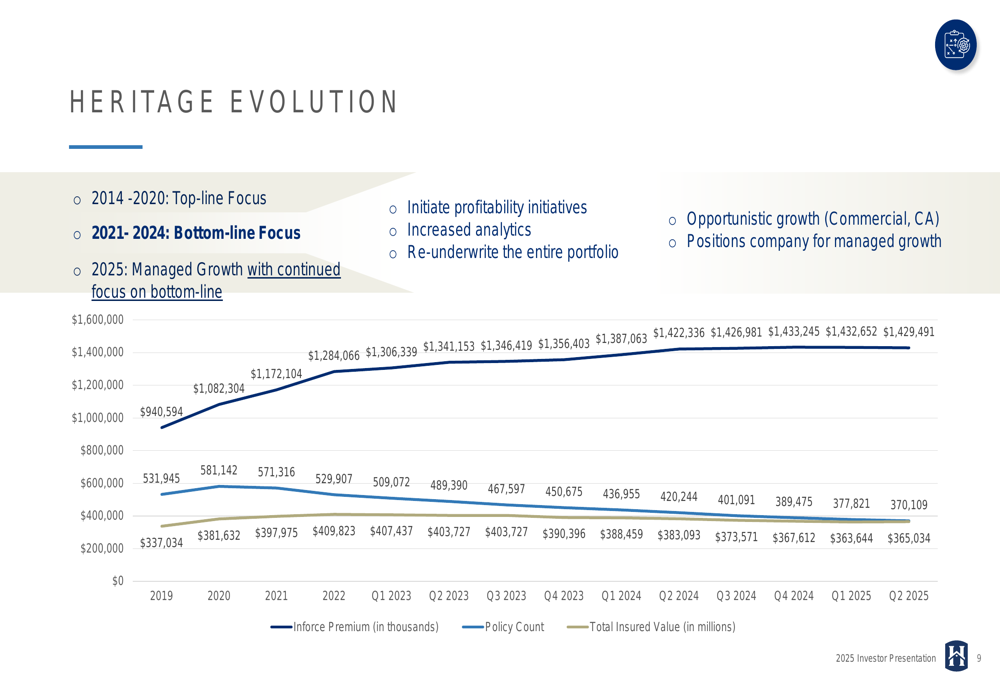
Geographic diversification remains a cornerstone of Heritage’s strategy, with 71.1% of total insured value positioned outside of Florida and 66.2% outside the Southeast region as of Q2 2025. This diversification has helped the company achieve better risk distribution, improved claims trends, and lower reinsurance costs.
The following map illustrates Heritage’s geographic footprint across the United States:
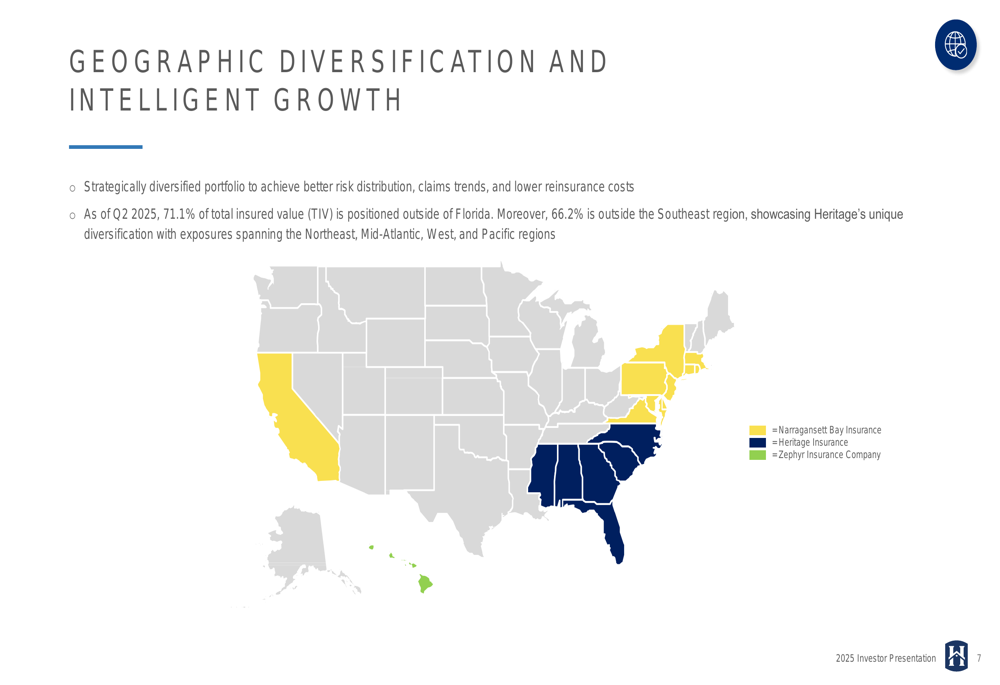
Financial Trajectory and Balance Sheet Strength
Heritage’s financial metrics show strong positive trends across multiple indicators. The company reported a book value per share of $12.36, total assets of $2.5 billion, and total equity of $383.3 million. Its market capitalization stands at approximately $773 million.
The company’s investment portfolio remains conservative, comprised primarily of short-duration, high-credit-quality fixed income securities with an average credit rating of A+. Investment income for Q2 2025 was $9.0 million.
The following slide provides a detailed breakdown of Heritage’s investment portfolio:
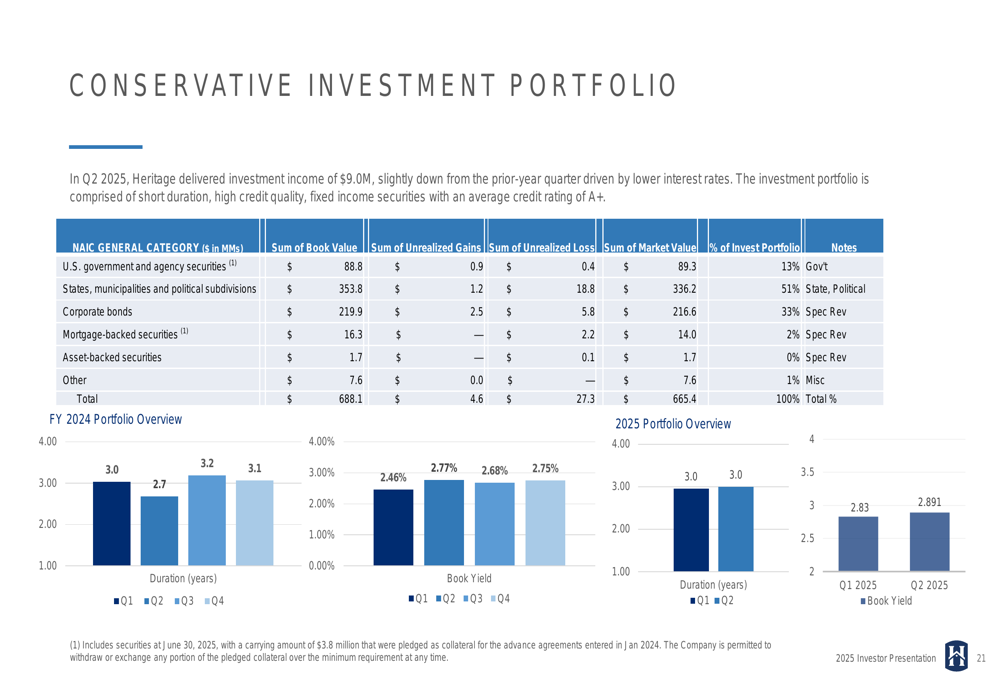
Key financial metrics have shown impressive compound annual growth rates, including shareholders’ equity (49.0% CAGR), book value per share (36.1% CAGR), and cash and invested assets (9.3% CAGR), while the debt to capital ratio has decreased at a CAGR of -23.8%.
These positive financial trajectories are illustrated in the following charts:
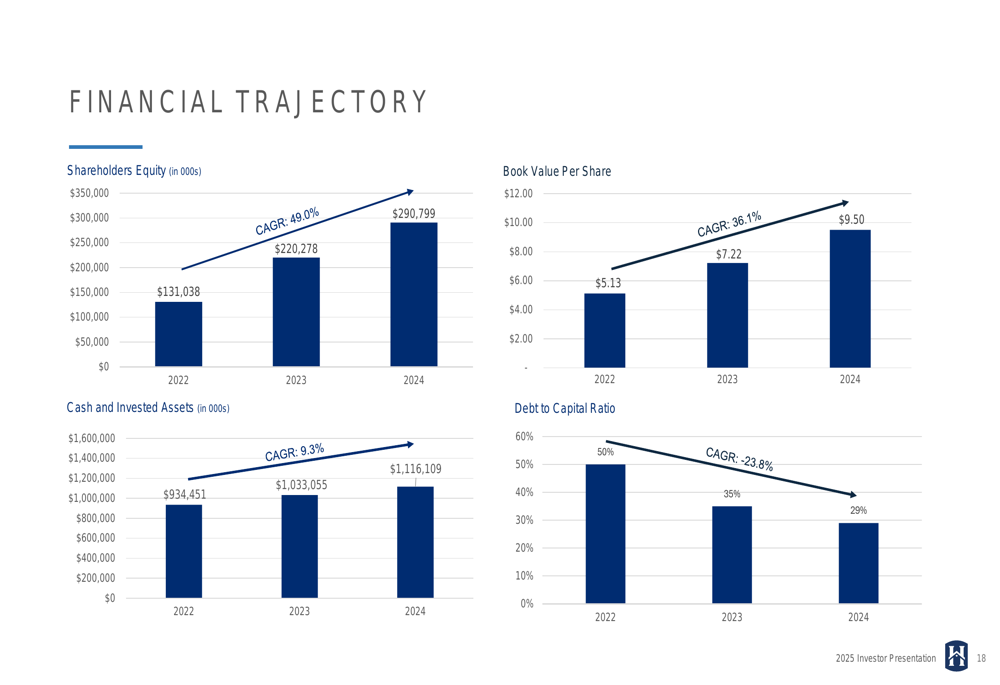
Heritage maintains a robust reinsurance program to protect its capital, with first event loss retention of $50 million in the Southeast/Mid-Atlantic and Hawaii regions, and $39.3 million in the Northeast. The company is well-capitalized to fund organic growth, with $329.6 million in combined statutory surplus as of Q2 2025.
Forward-Looking Statements
Looking ahead, Heritage expects to see its in-force policy count stabilize and return to growth in 2025 and 2026. The company has achieved rate adequacy in many of its geographic regions and plans to leverage its existing infrastructure while maintaining focus on risk management and stringent underwriting standards.
Management emphasized that Heritage will remain disciplined with a strategic focus that prioritizes long-term profitability and shareholder value. The company continues to evaluate dividend distribution and stock repurchases as part of its capital management strategy, though no repurchases of common stock were conducted in the recent period.
The presentation reinforces Heritage’s position as a super-regional U.S. property and casualty insurance holding company that has successfully navigated through challenging years to establish a foundation for sustainable growth and profitability. With its geographic diversification, vertically integrated structure, and focus on underwriting discipline, Heritage appears well-positioned to capitalize on market opportunities while managing risks effectively in the coming quarters.
Full presentation:
This article was generated with the support of AI and reviewed by an editor. For more information see our T&C.
